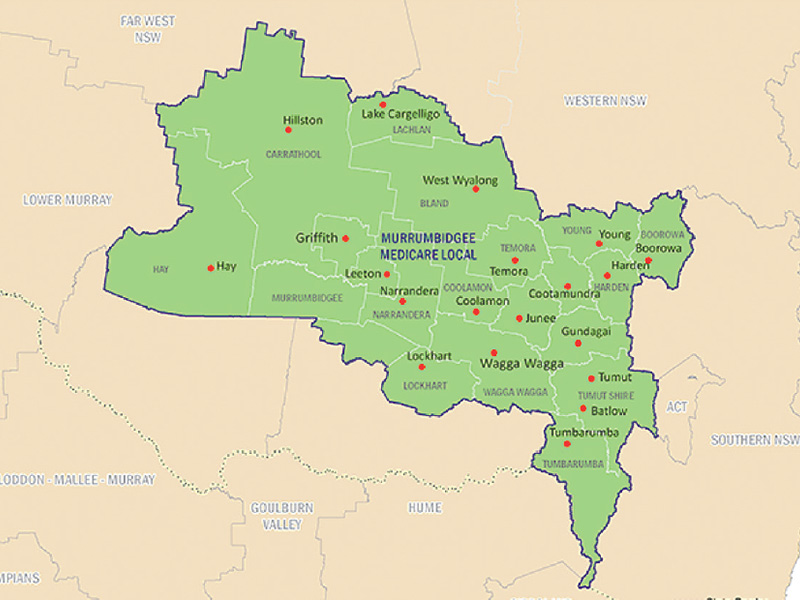Inactive and Overweight are just two findings that Murrumbidgee Medicare Local have flagged the Harden Shire residents suffer from in their Community Profile Report compiled on the area. Murrumbidgee Medicare Local Ltd evolved from the merger of the Murrumbidgee General Practice Network Ltd and the Riverina Division of General Practice and Primary Health Ltd. It is located in South West NSW covering a geographic region of 99,300 square kilometres, with a population of 180,000 people.
The MML region includes the Statistical Local Areas (SLAs) of Bland, Boorowa, Carrathool, Coolamon, Cootamundra, Griffith, Gundagai, Harden, Hay, Junee, Lachlan, Leeton, Lockhart, Murrumbidgee, Narrandera, Temora, Tumbarumba, Tumut, Wagga Wagga and Young.
There are many statistics detailing current health issues and projected numbers regarding population size, disease and demographics.
The Harden region is projected to have a small decrease in population over fourteen years from 2011 to 2025. The majority of residents are Australian-born, with an Indigenous Australian population larger than the NSW average.
Across the region, the most common cause of death was due to cardiovascular disease with the second most common cause of death due to malignant neoplasms. Compared to the NSW average, Harden had higher rates of physical inactivity and obese and overweight residents.
Prostate and breast cancer were the most common form of cancer within Harden. Incidence and death from cancer is high across the Harden region compared to the NSW average.
Harden is considered to be more socioeconomically disadvantaged than NSW, as it has a lower average wage and salary income.
The 2011 Census recorded 3,584 people as residents of Harden; the Public Health Information Development Unit (2012) has predicted that by 2025 the population will have decreased to 3,259 people. This translates to a predicted decrease in population of 10%; this is significantly lower than the predicted increase in population of 20% for NSW.
Harden has an estimated 3.6% residents with Type 2 Diabetes (2007-2008), slightly higher compared to the NSW rate of 3.5%.
The Harden region has an estimated 10.5% of the population with asthma (2007-08); this is slightly higher than the NSW average of 9.2%.
Harden has a higher number of people with a severe disability (5.6%); high compared to the NSW average (3.5%).
Harden had 148 reports of cancer from 2004-2008 and a standardised rate of 565.1 people per 100,000 population; this rate is higher compared to the NSW average rate of 483.2 per 100,000. Harden has one of the highest rates of cancer incidence across the MML region.
Harden had 58 reports of death from cancer from 2004-2008 and a standardised rate of 215.8 people per 100,000 population; high compared to the NSW average of 176.9 people per 100,000 population.
Across the Harden region, prostate cancer had an incidence rate of 88.8 per 100,000, higher compared to across NSW, where there were 6,917 new cases in 2008 making it the most common form of cancer.
Breast Cancer had the second highest rate of incidence with a rate of 84.4 per 100,000 across New South Wales.
Prostate cancer accounted for (33.1% of all new cancer in males Within the Harden region, Throughout July 2005 to September 2010 in NSW, the number of women being screened has increased and mortality from this cancer has decreased. Breast screening is utilised by 50% of the target population (women aged 50-69 years).
Deaths from other illnesses over the period iclude Colorectal 18, Lymphohaematopoietic 17, Lung 15 and Skin 12.
Overweight males in the Harden Shire account for 1/3 of the population with 24.5% in the obese category.
Overweight females account for 23.7 percent of the population with 17.2 percent in the obese range. The Harden region has a higher rate of smokers compared to the NSW average with 22.9% compared to 19.9%.
These figures highlight the health problems of the area some of which can be reveresed through diet and exercise. Please see your Doctor.

